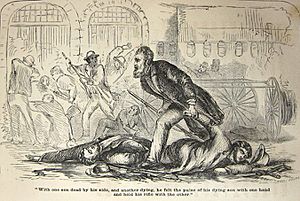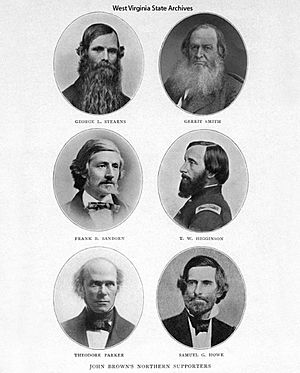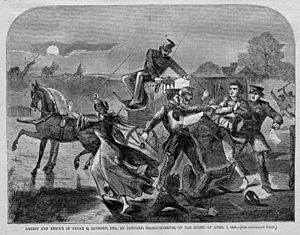Secret Six facts for kids
The Secret Six were a group of men who secretly helped pay for John Brown's attack on Harpers Ferry in 1859. John Brown was an abolitionist, meaning he wanted to end slavery in the United States.
While some people called them "wealthy," only two of the six men were actually rich. The other four were important people who could encourage others to give money to help end slavery.
The name "Secret Six" was not used at the time. Writers made up the name long after John Brown died. The men helped Brown on their own and did not work together as a group. They were never in the same room, and some barely knew each other.
Who Were the Secret Six?
The Secret Six were:
- Thomas Wentworth Higginson
- Samuel Gridley Howe
- Theodore Parker
- Franklin Benjamin Sanborn
- Gerrit Smith
- George Luther Stearns
All six men had been involved in the movement to end slavery before they met John Brown. They slowly became convinced that using violence was necessary to stop slavery in America.
Of the six, only Gerrit Smith and George Luther Stearns were truly wealthy. The others included two ministers (Parker and Higginson), a doctor (Howe), and a teacher (Sanborn). At that time, doctors were not usually rich.
Franklin Benjamin Sanborn, who later wrote about John Brown, was the main organizer among the group. He handled much of the money and letters related to the donations. He said, "we all raised money to aid Brown in carrying this plan forward."
Helping John Brown's Plan

John Brown planned to take weapons from a federal armory in Harpers Ferry, Virginia (which is now West Virginia). He wanted to start a slave rebellion in the South. It's not fully clear if the Secret Six knew all the details of Brown's plan. However, some of them were unsure about using violence to end slavery. Brown met with members of the Six several times in 1858 and 1859 to talk about how he would fight against slavery.
In October 1859, Brown's plan failed. People immediately wondered who was helping Brown, because his claim that the raid was his idea alone was not believed. Newspapers like New York Times and New-York Herald began to connect the names of the Six with Brown.
On November 7, Gerrit Smith went to a hospital for mental health, saying he was not involved in helping Brown. Howe, Sanborn, and Stearns went to Canada for a short time to avoid being arrested. Parker was already in Italy because people thought a warm climate would help his tuberculosis.
Sanborn insisted, "We did not know that Brown meant to begin there, in Virginia, at Harper's Ferry." Like Gerrit Smith, Sanborn felt it was okay to tell only part of the truth publicly. He said, "We expected he would go farther west, into a region less accessible, where his movements might escape notice for weeks."
On April 3, 1860, five federal marshals arrived at Frank Sanborn's home in Concord, Massachusetts. They handcuffed him and tried to force him into a coach to take him to Washington. There, he was supposed to answer questions from the Senate about his involvement with John Brown. About 150 townspeople quickly came to Sanborn's defense. A judge formally demanded that the marshals release Sanborn. Louisa May Alcott wrote to a friend that Sanborn was "nearly kidnapped."
Parker, who was dying from tuberculosis, stayed in Italy until he passed away in 1860. Higginson was the only member of the Six who stayed in the United States and openly supported Brown. He even planned to rescue Brown from jail, but Brown did not want to be rescued. Higginson asked Sanborn when Sanborn fled to Canada, "Can your clear moral sense justify our holding our tongues in order to save ourselves from the disapproval of society, even as that nobler man whom we did provoke to enter into danger becomes the scapegoat of that disapproval, going for us even to the gallows?"
What Happened Later
In January 1863, when the Emancipation Proclamation took effect, a celebration was held at the home of George Stearns. This event was also called a "John Brown party." Many famous people attended, including Sam and Julia Ward Howe, Frank Sanborn, Ralph Waldo Emerson, Wendell Phillips, and John Murray Forbes. Higginson, who was leading a black regiment of Union soldiers, could not attend. Gerrit Smith did not reply to the invitation. A marble statue of John Brown was shown at this time.
In 1867, Gerrit Smith helped pay to release Jefferson Davis, who had been the president of the Confederate States during the Civil War. Smith's wife wrote in 1874 that her husband had destroyed all his letters about John Brown. Sanborn also went through his own papers, removing anything that could connect him or his friends to Brown's raid. Only some letters to Theodore Parker, which came back to Sanborn after Parker's death, were not destroyed.
For the rest of their lives, Higginson, Sanborn, and Stearns often visited Brown's grave in North Elba, New York. Frank Sanborn made sure that John Brown's daughters received an education. Even after 1900, he continued to help Brown's children and grandchildren.
Higginson wished that the country could have been divided "without the sacrifice of Brown." He believed that the Six should have made a different plan for Harper's Ferry. He thought they should have protected Brown from himself, seeing "the madness that dwelled within him—the insanity that sat stealthily beside his great, selfless nobility."
In 1905, Higginson helped start the Intercollegiate Socialist Society. Other founders included lawyer Clarence Darrow, Jack London, and Upton Sinclair.
After Sanborn died in 1917, the House of Representatives of Massachusetts praised him for his life's work. They specifically mentioned Sanborn's role as a "confidential adviser to John Brown of Harper's Ferry." They noted that because of this, he was treated badly and wrongly arrested. He was saved from being sent away from Massachusetts only by a crowd of people.
|
See also
 In Spanish: Comité Secreto de los Seis para niños
In Spanish: Comité Secreto de los Seis para niños




